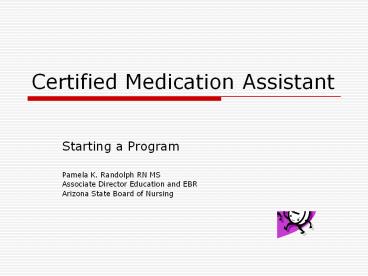Certified Medication Assistant - PowerPoint PPT Presentation
1 / 18
Title:
Certified Medication Assistant
Description:
... be made aware of Omitted medications that are not available from pharmacy Refused medications Crushing of ... Certified Medication Technician Author: – PowerPoint PPT presentation
Number of Views:414
Avg rating:3.0/5.0
Title: Certified Medication Assistant
1
Certified Medication Assistant
- Starting a Program
- Pamela K. Randolph RN MS
- Associate Director Education and EBR
- Arizona State Board of Nursing
2
Objectives
- Identify qualifications of students, facilities,
and faculty eligible to participate in CMA
education - List CMA course requirements
- Explicate the steps involved in starting a CMA
program - Discuss the importance of a culture of safety
when implementing the CMA role
3
Eligible Providers
- Accredited by the Private Post Secondary
Boardpost-secondary institution - Regionally or nationally accredited
post-secondary institution - Licensed long-term care facility
4
Faculty qualifications
- Must be RN with
- Unrestricted license and
- At least 40 hours of experience administering
medications to long-term residents
5
Student qualifications
- Students must
- Have completed High School
- Demonstrate English language proficiency if
educated in foreign country - Be 18 years or older
- Be a CNA in good standing and
- Have worked as a CNA for at least 6 months
- Demonstrated ability in math and reading
comprehension
6
Program Completion
- Either Complete
- Approved AZ CMA program
- Equivalent CMA program in another state
- Equivalent portion of RN or LPN program
- Successfully pass a 45 hours pharmacology course
- 40 hours of medication administration in a
licensed long term care facility - Successfully completed a nursing clinical course
7
Testing
- Pass written and manual skills test administered
by D and S technologies
8
Curriculum
- 100 hours
- 45 hours theory
- 15 hours skill practice
- 4 unit tests plus a comprehensive final
- 75 on each test and 80 on final
- 40 hours of progressive clinical practice
- 11 for first 12 hours with instructor
- 13 for next 12 hours
- 16 hours under general supervision of instructor
at 15 ratio or less
9
Course GuideBoard provided
- General Policies provided
- Medication administration protocols provided
- Objectives and content provided
10
Steps to Success
- Decision to providefeasibility safety
- PartnersCommunity college/facility outside
entity - Secure qualified instructor
- Facility contract
- Extra instructors at facility to help with
clinical - Review guidelines and curriculum
- Select text and other resources
- Determine appropriate reading for each unit
- Prepare didactic sessions
- Develop item pool for examskeep secure
11
Steps to Success--Continued
- Develop course policies
- Set tuitionfinancial policies
- Select screening tool and passing standardTABE
is used at community collegespartnership could
be developed for centralized screening - Submit course application to State Board of
Nursing
12
Questions ?
- PSMT sites must re-apply to be a CMA siteMay
finish any training in progress - Suggested textbooks in course guidelines
13
Safety
- It is not a question of is the CMA safe
- It is a question of under what conditions can a
licensed nurse safely delegate to a CMA?
14
Conditions
- Culture of the organization
- Is safety a priority?
- How do you currently ensure that residents are
administered medications safely? - How rapid is the response from your pharmacy?
- How involved will licensed nurses be in the
oversight of medication administration? - Is efficiency prized above safety?
15
Oversight
- All medications must be delegated by licensed
nurse - Cannot delegate
- PRNs except OTC analgesics/bowel meds at the
direction of the nurse following assessment - The first dose of a new med or if a currrent med
has changed the dose - Parenteral medications including patches and
sublingual medications - Medications inserted into G or NG tubes
- Oxygen/inhalant medications
- Any medication that requires mathematic
conversion between dosage systems - Where delegation would pose a risk
16
Delegating Nurse
- Must be made aware of
- Omitted medications that are not available from
pharmacy - Refused medications
- Crushing of tablets (must approve)
- Requests for PRNs and document an assessment and
evaluation of response
17
Summary
- Course, instructor and student requirements are
prescribed in statute - Programs must test prospective students and
develop assignments/tests related to curriculum - A culture of safety in the institution will
protect residents/nurses/ and CMAs
18
Contact
- Pamela Randolph
- Associate Director Education and Evidence-based
Regulation - prandolph_at_azbn.gov
- 602-771-7803































